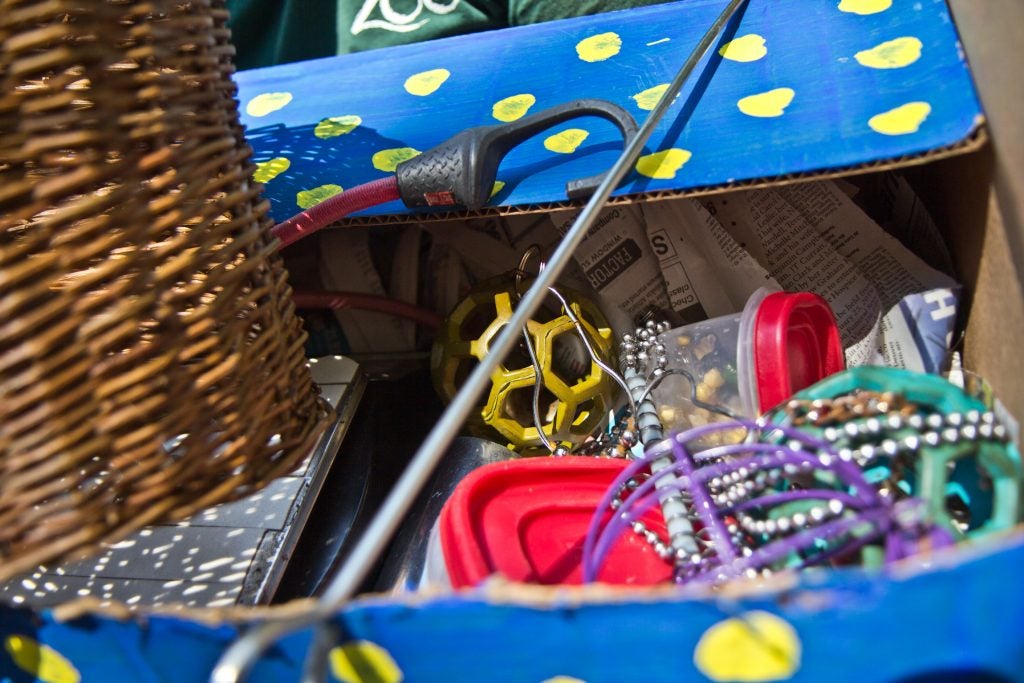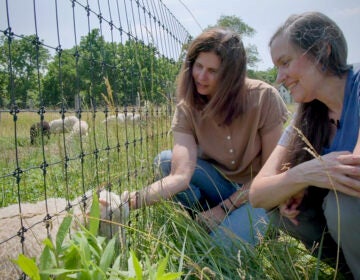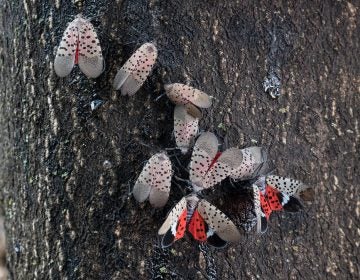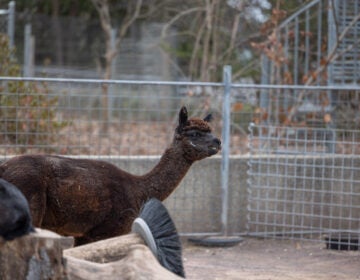Which animals play, and why?
It wasn’t until a few years ago that researchers defined what really counts, to animals, as play.
Listen 06:44
Mo, a black-headed caique, peers out of his cage at the Bradywine Zoo. (Kimberly Paynter/WHYY)
It was a big day for Mo, a black-headed caique. He’s a small parrot, not as big as a pigeon, with green wings, a white belly, and a black and yellow head.
Mo lives by himself inside a large cage at the Brandywine Zoo in Wilmington, Delaware. Lead animal keeper Katlyn Muse just put in a bunch of new toys: bells (one of his favorites); a wicker tunnel; and a cardboard box with shredded newspaper inside.
Muse hid small bits of food all around, and stepped out. Mo crawled inside the tunnel, dug under the newspaper, and flitted around the cage to find all the hidden treats.
“We give them things that are going to encourage natural behaviors,” Muse said. “So for these guys, they would be foraging a lot, constantly looking for food, so we find places to hide their food, spread their food out.”

This is called enrichment, a kind of play, and it’s important work for zoos, explained assistant curator Mandy Fischer.
“There’s some species where play is very important, so a lot of our primate species, for baby animals in particular, play is how they learn some of those life skills that they’ll need for hunting, or for breeding behaviors, or caring for young … can all be done through play,” Fischer said. “Some of our animals, though, it is purely exercise, they are built for speed or built for strength.”
To figure out which animals play, whether to learn or just for a workout, think about it from an animal’s point of view, said Gordon Burghardt, professor in the Departments of Psychology, Ecology, and Evolutionary Biology at the University of Tennessee, Knoxville.
“Our … biases … inhibited us from looking at other animals from a less anthropomorphic viewpoint … and see that something like play is really deeply embedded into our biological roots, our evolutionary heritage,” he said.
Burghardt has become one of the experts on animal play, and he recently came up with a more rigorous definition of it, to try to break free of the limits of a human-centered perspective.
To put it very simply, something counts as play for animals if they do it voluntarily over and over again, only when they’re not stressed, and it’s somehow different than a more serious version of that behavior.
For instance, play wrestling is not the same as serious fighting. And one particular type of spider will actually play at having sex when it is not mature yet. It’s play and not real sex because the females are far less likely to eat the males afterward.
Learning how to tell when something is play could be one of the reasons animals do it, said Marc Bekoff, professor emeritus of ecology and evolutionary biology at the University of Colorado, Boulder.
Play is important for social, physical, and cognitive development, but it also prepares animals for the unexpected, he said. Play behavior can vary so much; animals need to be able to tell when something is play rather than real aggression or a mating display. For example, chimpanzees have something called a “play face,” and dogs do something called a“ `play bow’ — rump high in the air with forelimbs pressed into the ground.”

Animals that don’t get to play can face serious consequences.
Think about how barren zoos used to be, Burghardt said: The design philosophy was all about making them easy for humans to clean.
“Lions might be in a tile, concrete type of enclosure that could be hosed down every day, and there was virtually nothing in it … that would hinder the efficient cleaning,” he said. “That might have made the animals’ housing more sterile, but also completely uninteresting and would have psychological consequences, similar to keeping people in jail cells.”
Bored caged animals can develop tics, like pacing, or bar biting.
Ravens are another good example of how animals can suffer from a lack of stimulation.
Rebecca Michelin, director of wildlife rehabilitation at the Schuylkill Center for Environmental Education, nurses injured animals back to health before releasing them back into the wild. In a previous job, she worked with a lot of ravens, and she said that while ravens are healing, they still need stimulation.
“Keeping them entertained is really challenging because they’re so intelligent that they need changes to their environment on a regular basis,” she said. “They need mental challenges to keep them entertained and keep them busy, otherwise they’ll actually start self-harming out of boredom and unhappiness.”
Bored and stressed-out ravens will peck at their own feathers, she said, or even beat their wings against the side of a cage so hard that they become seriously injured.
Boredom is an important issue for research animals, too. Mice and rats in labs have to live in enclosed spaces, and researchers take care to give them tubes to crawl inside and sticks to chew on. Tara Martin, faculty veterinarian at the University of Michigan, said that if research animals are bored and stressed, that’s bad for the animals — and it’s also bad for science.
“An animal that lives in a barren environment is a pretty stressed animal,” Martin said. “It can affect hormones within their body, it can affect their immune system, it can certainly affect brain development. And when you have all of those effects, they all can act as confounds on your research, so they can alter the results of your research.”
WHYY is your source for fact-based, in-depth journalism and information. As a nonprofit organization, we rely on financial support from readers like you. Please give today.






